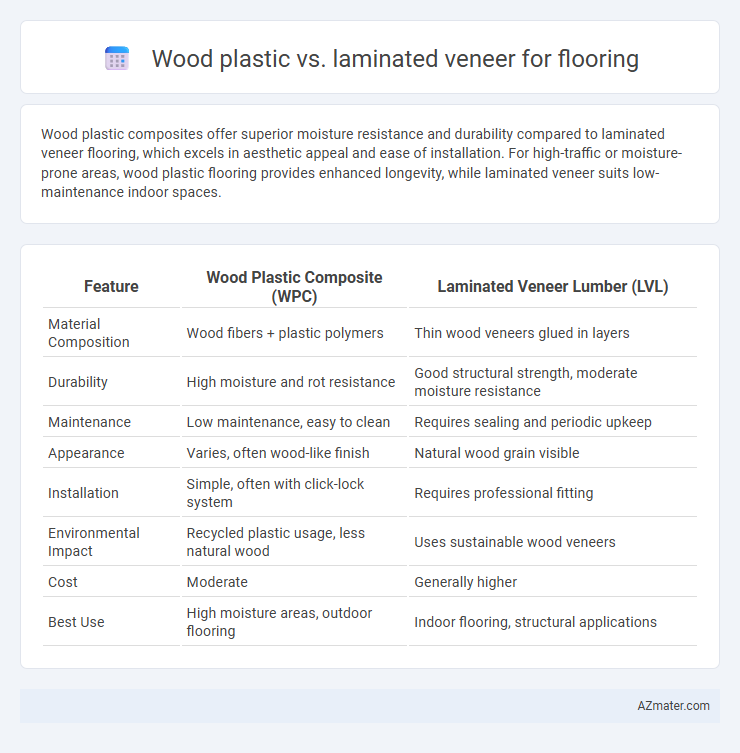Wood plastic composites offer superior moisture resistance and durability compared to laminated veneer flooring, which excels in aesthetic appeal and ease of installation. For high-traffic or moisture-prone areas, wood plastic flooring provides enhanced longevity, while laminated veneer suits low-maintenance indoor spaces.
Table of Comparison
| Feature | Wood Plastic Composite (WPC) | Laminated Veneer Lumber (LVL) |
|---|---|---|
| Material Composition | Wood fibers + plastic polymers | Thin wood veneers glued in layers |
| Durability | High moisture and rot resistance | Good structural strength, moderate moisture resistance |
| Maintenance | Low maintenance, easy to clean | Requires sealing and periodic upkeep |
| Appearance | Varies, often wood-like finish | Natural wood grain visible |
| Installation | Simple, often with click-lock system | Requires professional fitting |
| Environmental Impact | Recycled plastic usage, less natural wood | Uses sustainable wood veneers |
| Cost | Moderate | Generally higher |
| Best Use | High moisture areas, outdoor flooring | Indoor flooring, structural applications |
Introduction to Modern Flooring Materials
Wood plastic composite (WPC) flooring combines natural wood fibers with durable plastic polymers, offering moisture resistance and enhanced longevity compared to traditional materials. Laminated veneer lumber (LVL) flooring utilizes layered thin wood veneers bonded under heat and pressure, providing superior strength and stability for structural applications. Both materials represent modern advancements in flooring solutions, catering to different performance needs and aesthetic preferences.
What is Wood Plastic Composite (WPC) Flooring?
Wood Plastic Composite (WPC) flooring is a hybrid material combining wood fibers and thermoplastics like polypropylene or polyethylene, resulting in a durable and water-resistant surface. Unlike laminated veneer flooring, which uses thin layers of real wood bonded together, WPC flooring offers enhanced resistance to moisture, making it ideal for high-humidity areas such as kitchens and bathrooms. The core of WPC flooring provides superior dimensional stability and ease of installation compared to traditional laminated veneer options.
Overview of Laminated Veneer Flooring
Laminated veneer flooring consists of multiple layers of wood veneers bonded under heat and pressure, offering enhanced stability and durability compared to solid wood. Its construction provides improved resistance to moisture, making it suitable for various indoor environments. This flooring type delivers a natural wood appearance with greater affordability and ease of installation than traditional hardwood.
Durability Comparison: WPC vs Laminated Veneer
Wood Plastic Composite (WPC) flooring exhibits superior durability compared to laminated veneer due to its resistance to moisture, warping, and insect damage, making it ideal for high-traffic or humid environments. Laminated veneer flooring, while cost-effective and visually appealing, is more prone to surface wear, scratches, and delamination under heavy usage or exposure to water. WPC's enhanced dimensional stability and wear layer contribute to a longer lifespan and reduced maintenance needs compared to laminated veneer flooring.
Aesthetic Appeal and Design Options
Wood plastic composites offer a wide range of textures and colors mimicking natural wood grains with enhanced durability, making them popular for modern, low-maintenance flooring designs. Laminated veneer flooring showcases authentic wood patterns with rich, natural hues and intricate grain details, providing a classic, warm aesthetic favored in traditional and high-end interiors. Both materials allow custom finishes and patterns, but laminated veneer excels in delivering authentic wood beauty, while wood plastic provides versatile, weather-resistant options.
Installation Methods and Ease
Wood plastic composite flooring typically features a click-lock installation system that requires minimal tools and expertise, making it suitable for DIY projects and reducing installation time. Laminated veneer flooring often uses a similar floating floor technique but demands a precise subfloor preparation and acclimatization period to prevent moisture issues and ensure proper locking of the planks. Both flooring types offer straightforward installation, but wood plastic composites generally provide greater ease due to their moisture resistance and uniform material composition.
Moisture and Water Resistance
Wood plastic composite (WPC) flooring offers superior moisture and water resistance compared to laminated veneer flooring due to its synthetic polymer and wood fiber blend, which prevents swelling and warping. Laminated veneer flooring, made from thin wood layers bonded under heat and pressure, is more susceptible to water damage and moisture absorption, potentially leading to delamination and deterioration. WPC flooring's enhanced durability in wet environments makes it ideal for areas prone to high humidity or occasional water exposure.
Maintenance and Cleaning Requirements
Wood plastic composite flooring requires minimal maintenance, as it resists moisture, staining, and fading, making regular sweeping and occasional mopping sufficient for cleaning. Laminated veneer flooring demands more care to prevent moisture damage and scratches, often needing specialized cleaners and prompt spill cleanup to maintain its appearance. Both options benefit from using protective pads under furniture and avoiding abrasive cleaning tools to extend their lifespan.
Cost Analysis: Initial and Long-Term
Wood plastic composite (WPC) flooring generally has a higher initial cost compared to laminated veneer flooring, but it offers superior durability and moisture resistance that can reduce maintenance expenses over time. Laminated veneer flooring is more affordable upfront, making it attractive for budget-sensitive projects, yet it may require replacements or repairs sooner due to susceptibility to wear and water damage. Considering long-term investment, WPC flooring tends to provide better value through longevity and lower life-cycle costs despite the higher initial expenditure.
Environmental Impact and Sustainability
Wood plastic composites (WPC) flooring offers a sustainable alternative by utilizing recycled plastics and wood fibers, significantly reducing landfill waste and deforestation. Laminated veneer flooring relies on thin wood layers bonded with adhesives, often sourced from rapidly renewable forest products but may involve chemical treatments impacting indoor air quality. WPC flooring generally demonstrates a lower environmental footprint due to its recycled content and resistance to moisture, extending product lifespan and minimizing resource consumption compared to laminated veneer flooring.

Infographic: Wood plastic vs Laminated veneer for Flooring
 azmater.com
azmater.com